This master list of finger foods for toddlers, babies, and kids is your go-to list for healthy and delicious foods the kids can feed themselves…and easily and safely chew!
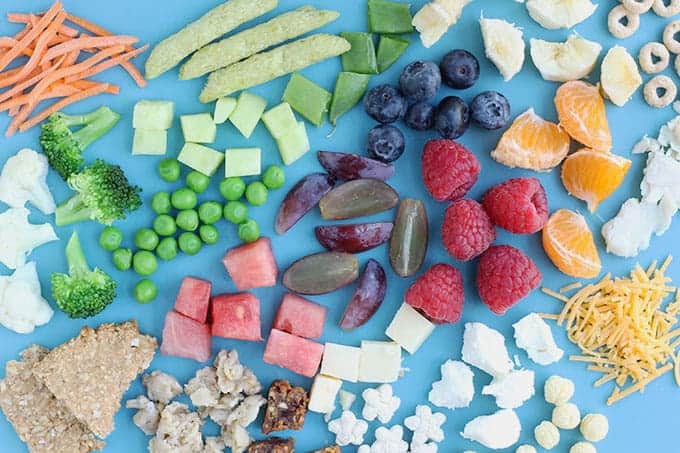
Healthy Finger Foods for Kids
When little ones want to feed themselves, which often happens soon after starting solids, it’s a perfect time to introduce healthy, fresh foods to make the most of their enthusiasm. Fruits, veggies, whole grains, meats, fish, beans, and more are easy finger food ideas that are often super easy to prepare and easy for the kids to pick up and eat.
In this post you will find lists of recommended foods, suggestions for how to cut and prepare them, and images of examples of what those foods may look like as your child grows.
TIP: I love to keep finger foods in the mix even as kids get older since they make for simple, healthy snacks that are usually low cost and low prep.
Safe Finger Foods for Kids
A good rule of thumb to help prevent choking or excessive gagging is to avoid anything:
- hard (like a raw carrot)
- round (like a slice of hot dog or a whole grape)
- sticky (like a spoonful of nut butter)
- very chewy (like gummy candy)
If you are just starting out with baby led weaning or if baby is younger than 9 months, longer sticks of foods are usually easier to pick up and self feed. Once a baby has mastered her pincer grasp around the age of 9 month and can pick up a food like a puff or a Cheerio with their fingers, you can move on to soft diced foods.
Stick with softer foods to start with that are easy to chew.

First Finger Foods for Babies
Foods that squish easily between your fingers are a safe bet for babies and younger toddlers. Think cooked peas, raspberries, chunks of banana, diced avocado, and soft cheese. Aim to cut food into small pieces—roughly the size of a pea or two—as they start eating finger foods to give them plenty of chances to practice eating and chewing.
Always adjust sizes of foods to suit the age and eating experience of your own child and add more complicated textures as they grow.
TIP: Find my best first finger foods for babies here.
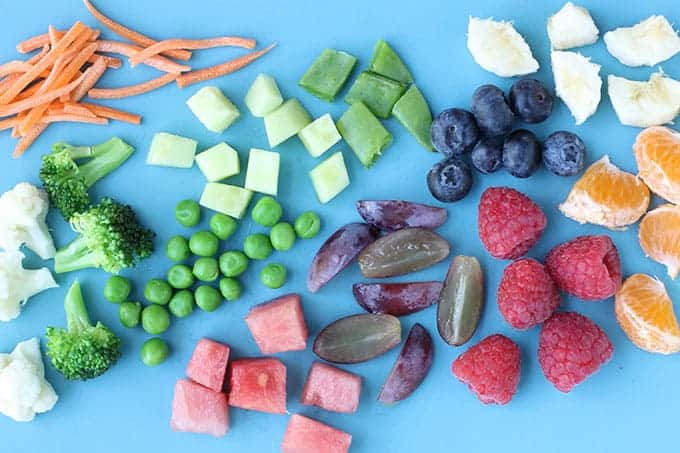
Finger Foods for Toddlers and Babies: Fruit
Fruit is a wonderful finger food for kids since it’s often very flavorful and usually needs little to no prep. Below are some of my favorite fruits for kids, along with serving suggestions
- Apples, shredded or cut into matchsticks, or steamed or roasted until soft
- Bananas, broken up and sectioned (these are easier to pick up than slices, which can be slippery)
- Blueberries, halved if large
- Raspberries, halved if large
- Blackberries, halved if large
- Strawberries, diced
- Clementines or oranges, halved or diced
- Grapes, sliced in half or quarters vertically
- Kiwi, diced
- Watermelon, diced or in sticks
- Cantaloupe, diced (make sure it’s very ripe and soft)
- Cherries, pitted and chopped
- Honeydew, diced (make sure it’s very ripe and soft)
- Mango, diced (make sure it’s very ripe and soft)
- Pears, very ripe and soft served diced with or without the skin or cut into matchsticks
TIP: Find my Master List of Fruit for Kids.
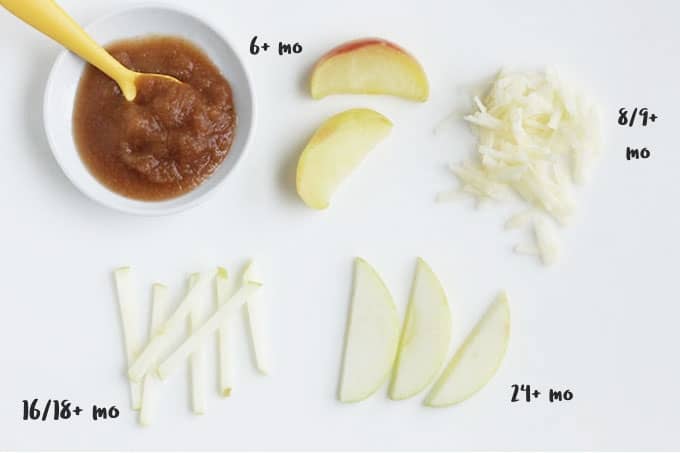 How to Serve Apples
How to Serve Apples
Here’s an example of the progression of what it might look like to serve apples as finger foods.
- (6+ mo) Applesauce, unsweetened
- (6+ mo) Steamed or baked apple slices: served BLW style, the baby will be able to pick up the pieces and suck off the tender flesh, then discard the skin.
- (8/9+ mo) Raw, grated, using softer varieties like MacIntosh or Gala and offer a small amount at a time.
- (16/18 mo +) Raw sticks, using softer varieties here too and sit with your kiddo to see how they do.
- (2 yr + ish) Raw slices. Use soft varieties and see how your toddler does. Many toddlers at this age can actually eat whole apples, but some can’t so you need to see what works for your child!
TIP: Sauteed Cinnamon Apples are a really great finger food option using apples.
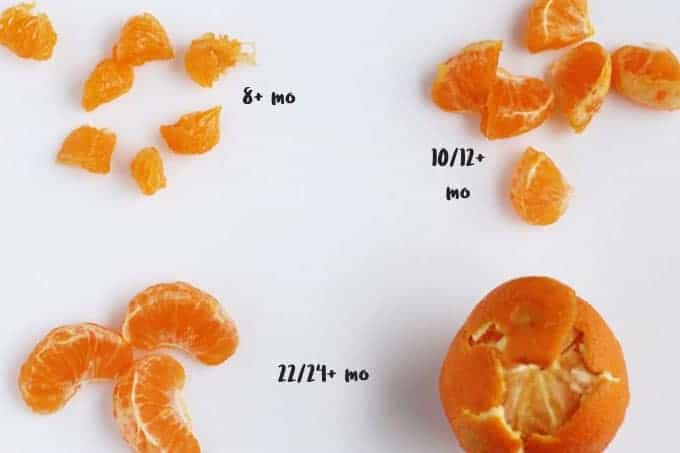 How to Serve Clementines
How to Serve Clementines
And here’s what it might look like to serve clementines as finger foods.
- (8-ish+ mo) Clementine flesh, outer membrane removed. Or, mash them more and serve on a preloaded spoon. See if baby likes the texture…or not! P.S. Canned mandarin oranges in water (NOT syrup) with no added sugar are a super soft option that many babies and toddlers love.
- (10/12+ mo ish) This will depend on the baby and how they’re doing with finger foods, but the segments are easier to chew and move around when the membrane is cut in half. Can cut smaller if desired. Can continue to remove the membrane if needed/preferred.
- (Closer to 2, with discretion) Whole segments. My 2.5 year old can usually eat these with no problem, but she still may have a hard time chewing them and sometimes spits them out. And serving with the whole peel, with it started so they can remove it themselves, is a great way to practice fine-motor skills as they finish peeling the fruit! (They can practice peeling earlier though you may need to cut the fruit if needed.)
TIP: You can also slice with the peel on as shown here.
Finger Foods for Toddlers and Babies: Vegetables
Most raw veggies will be too hard for little ones to chew, so read the suggestions below for easy ways to cook them—and for advice on which work well served raw.
- Avocado, cubed or sliced
- Butternut squash, steamed or roasted until soft
- Broccoli florets, steamed or roasted
- Carrots, shredded and served raw to toddlers over 18 months or diced and steamed or roasted until soft
- Cauliflower florets, steamed or roasted
- Cherry tomatoes, halved or quartered
- Cucumbers, sliced or diced (you may want to wait until over at least 18 months and then remove the skin)
- Snap peas, diced fresh for kids over 2 or steamed for younger eaters
- Sweet potato, peeled, diced and roasted until soft, or roasted whole until soft and served in pieces
- Thawed frozen peas (or still frozen for older toddlers!)
- Thawed frozen corn
- Thawed edamame, cut in half as needed
- Zucchini or yellow squash, diced or sliced and sauteed, steamed, or roasted
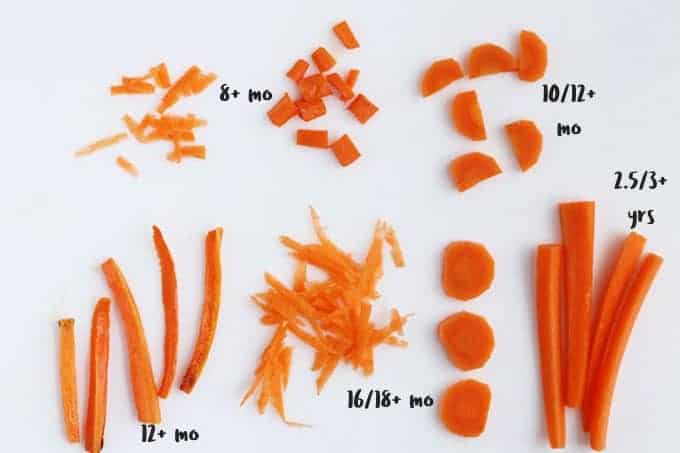
How to Serve Carrots
Here’s a progression of options for serving carrots as finger foods from babies on up as an example.
- (8+ mo) Steamed or boiled grated carrot: Very soft small pieces are easy to chew and a good fine motor exercise in picking up.
- Diced Roasted Carrots: Toss carrot sticks with olive oil and roast on a baking sheet at 400 for 10-12 minutes or until soft. Dice.
- (10/12 mo+) Halved Carrot Coins: Easy to pick up and less of a choking hazard than full coins. Serve them steamed, sauteed, or roasted.
- (12+ mo) Roasted Carrot Sticks: You can try these earlier, especially if doing BLW, though many younger kids will stuff the whole thing into their mouths (which can get stuck).
- (16/18 mo+) Grated Raw Carrot: This can be an interesting texture for toddlers and can be a nice introduction to salad. Serve a small amount at first to see how they do with the texture.
- (16/18 mo+) Steamed/Sauteed/Roasted Carrot Coins: I like to cut them for a while just to make sure the kids can chew them well, but serving rounds is a fun way to change up the shape.
- (2.5/3 yrs+) Raw Carrots: It’s entirely possible that your toddler will be okay with these at 2. Or not until 4. Cut the sticks thinly. Use your instincts with this one since it can be a choking hazard!
TIP: We love these Easy Sauteed Carrots and Roasted Carrot Fries.
 How to Serve Broccoli
How to Serve Broccoli
Here’s what a progression of serving broccoli as finger foods might look like.
- (6 mo +) Cooked with potatoes or sweet potatoes and mashed. You can mash super soft chopped florets into hard cooked egg yolk.
- (8/9 mo +) Steamed or roasted very tender florets: I’d avoid the stem since it can be very tough. Progress from smaller to slightly larger pieces to help them learn to move the texture in their mouths.
- (18/20 mo+ or according to when your kiddo can bite and chew thoroughly): Full-size florets, steamed or roasted: If steamed, toss with a little olive oil, butter, or toasted sesame oil for additional flavor. (This is also a method of serving broccoli BLW that my kids loved—but they more suck/gnaw than chew it all up so expect a fair amount to come back out!)
TIP: Find my favorite Roasted Broccoli here.
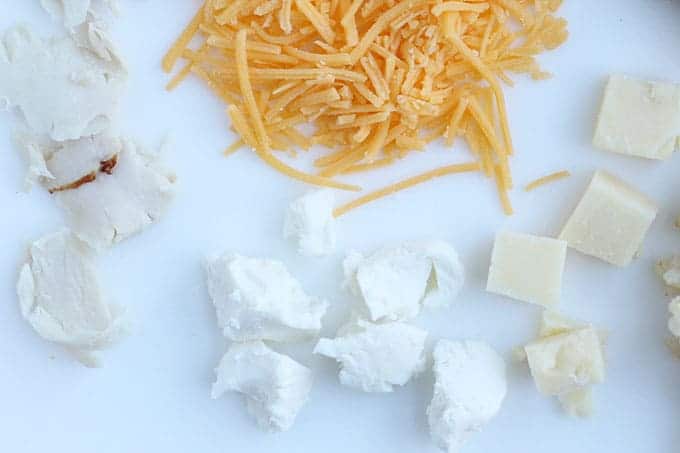
Finger Foods for Kids: Dairy
Dairy is an often overlooked finger food but there are so many easy ways to serve it!
- Cheese, diced or shredded
- Goat cheese, crumbled
- Cottage cheese, 4% offered on preloaded spoons or on a highchair tray (yes, it’s messy!)
- Frozen yogurt drops
- Hard cooked eggs, diced (yolks may be easier to chew, but some kids only like the whites)
- Scrambled eggs
- Egg muffins, diced
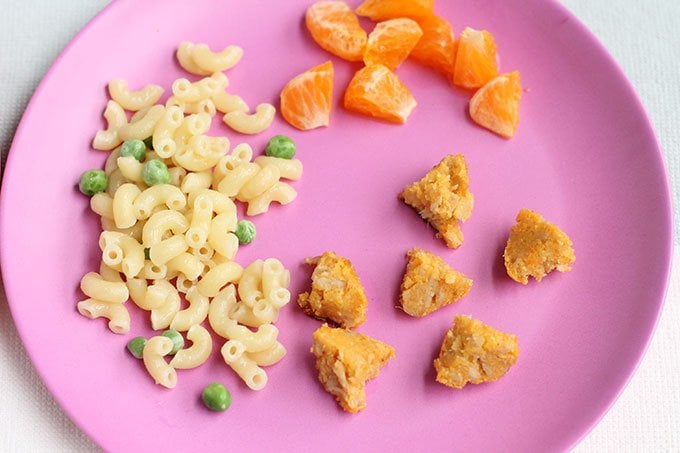 Finger Foods for Toddlers and Babies: Meat/Poultry/Fish
Finger Foods for Toddlers and Babies: Meat/Poultry/Fish
It’s easy to serve meat, poultry, and fish to little kids as long as it’s soft and easy to chew. Here are some ideas.
- Beef, ground and cooked through and either diced (if in something like a meatball) or served mashed.
- Beef, shredded (anything cooked in a slow cooker or instant pot and shredded is likely to be an easy texture to chew)
- Chicken, ground and cooked through and either diced (if in something like a meatball) or served mashed
- Chicken, diced (just be sure it’s not too dry)
- Chicken, shredded (anything cooked in a slow cooker or instant pot, like my Butter Chicken, and shredded is likely to be an easy texture to chew)
- Deli meat (sliced turkey, ham, or salami, cut up into small pieces)
- Fish Sticks
- Meatballs, diced or slightly mashed
- Salmon, poached or baked and diced or shredded
- Shrimp, cooked until very soft and diced
- Turkey, roasted breast or thigh meat and diced or shredded; or ground and cooked through
- Tilaipa, cooked and shredded
- White fish, cooked through and diced or shredded
Finger Food Ideas: Legumes/Nuts
You may want to mash beans slightly to make sure they are soft for the kids.
- Hummus (with a cracker for dipping)
- Chickpeas (like these Soft-Baked Cinnamon Chickpeas)
- Edamame, steamed or boiled according to package directions
- Energy bites, diced
- Larabars minis, diced (for over 12-18 months)
- Finely chopped cashews and walnuts (2 or 3 and up)
- Frozen peas, thawed
- Nut butter (on toast cubes or sticks)
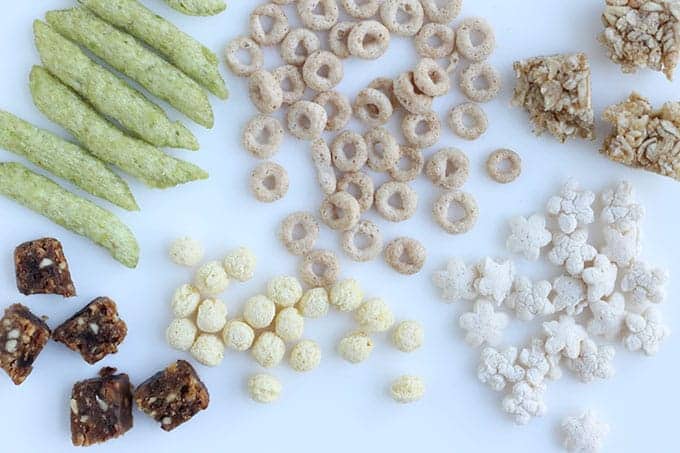 Finger Foods: Whole Grains
Finger Foods: Whole Grains
Whole grains, whether cooked from scratch or served in a food like bread or a muffin, are a nutritious category of finger food ideas.
- Oatmeal, cooked until it’s nice and thick so it’s easy to pick up with fingers (you can also add 1 teaspoon chia seeds, let sit for 5 minutes, and it will thicken up)
- Baked Oatmeal Cups
- Crackers, whole grain (Breton and the whole grain mini rounds in the brown box from Trader Joes are nice and soft)
- Soft snack bars, homemade granola bars, or Dino Bars
- French toast, diced
- Muffins, diced
- Pancakes, diced
- Rice, fully cooked until soft with mashed avocado or shredded cheese to help it hold together as needed
- Quinoa, fully cooked until soft with mashed avocado or shredded cheese to help it hold together as needed
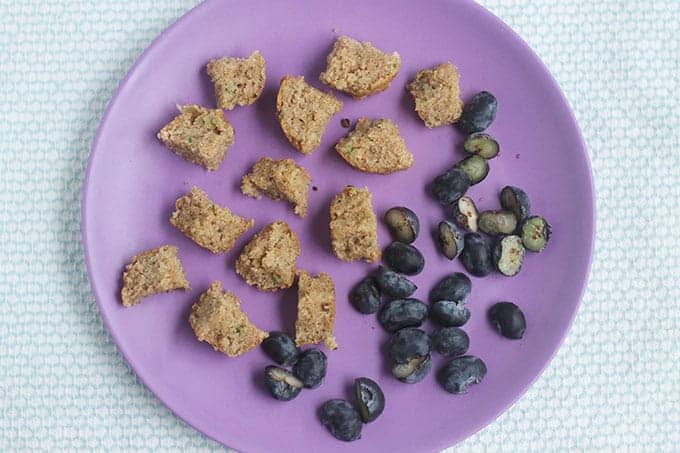 Easy Finger Food Ideas: Snacks
Easy Finger Food Ideas: Snacks
Having a few go-to store-bought snack food options is super handy. These are some of my favorites.
- Cheese crackers
- Cereal (low sugar): Cherrios, Kix, Chex
- Mini rice cakes
- Puffs (like Plum Organics or Happy Baby)
- Snap pea crisps
- MySuperFoods Maple Graham Bars, Nature’s Bakery Fig Bars, and Dino Bars
- Quinoa Chips (these are softer than regular chips, and high in protein; best for over 2 or 3)
- Whole grain crackers (we like Bitsy’s Brainfood)
- Whole grain graham crackers
- Veggie Straws
My baby/toddler has no teeth—can he eat finger foods?
Absolutely! Gums are incredibly strong, as is the tongue, so how many teeth your baby or toddler has (or doesn’t have!) is not an indication of how well they will be able to eat finger foods. The key is to make sure that the foods are soft enough for them to chew and the pieces are an appropriate size.
Finger Foods for Kids at Daycare
The foods in this post can be really helpful when packing food for daycare to make meals easy for your baby or toddler to eat. Aim for a mix of nutrients with whole grains, protein, fat, and lots of produce to help them meet their nutrient needs.
The lists in this post are designed for kids over 9 months. For younger babies doing baby-led weaning, serve foods in longer/larger pieces as needed, and avoid anything that’s not soft enough for them to easily chew. (The foods should still squish between your fingers easily or dissolve quickly like a puff.)
Sit with your kids whenever they eat and especially whenever they try new foods to see how they handle it—and so you can see if you need to cut things bigger or smaller to meet them where they are.
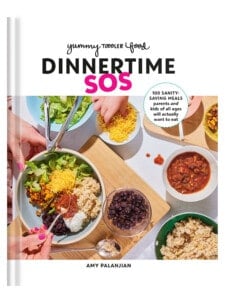
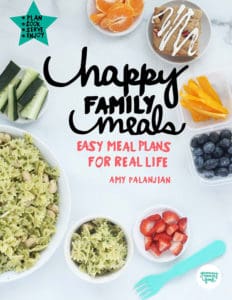

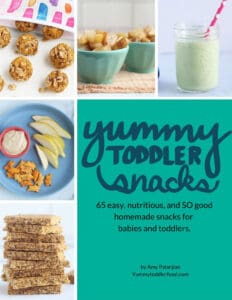














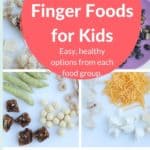
I look at this list before every grocery trip. Thank you!
I’m so glad it’s helpful!
This is AWESOME! I’m a first-time mom with a 14 month old baby who is allergic to dairy AND soy (OMG) so finding a variety of healthy food options that she won’t choke on is really hard!!! I appreciate you taking the time to create this and share it!
I’m so glad that it’s helpful!
This is so helpful! Thank you from Saratoga Springs!
You’re so welcome!
This was so helpful. Thank you, Amy.
I’m so glad to hear that!
I came across the idea of finger food for babies, while reading ‘how to introduce solid foods to your baby’ by Susan Urban from parental-love.com and I thought that it is a brilliant thing! Since then I’m exploring internet for more ideas what to give to my son in this form. Thanks for this article!
Such a helpful list!
This is so relevant for my family right now! As we follow a primarily Baby Led Weaning approach with our son, we’re constantly looking for new foods give him as snacks in between meals, or as part of a meal if there is something he might not be able to handle at this point. I love how it is broken down into the food groups as well. Sometimes I find myself with many options for one food group (dairy) and not so many options in others (meat). I will definitely be referring to this frequently in the coming months (and perhaps years)!
So helpful! It’s amazing what I forget from the first time around!
What a nice comprehensive and thoughtful listing. It’s bookmarked! I will enjoy sharing this as well! Thank you!
Hi there, my 9.5 month old baby gags a lot on soft finger food and her pincer grasp hasn’t developed yet. So I’m either giving her really small pieces of food on a preloaded spoon or she gets finger foods but I’m very concerned about the excessive gagging. It gets to the point where her face turns red and it looks like she’s struggling to breath until she manages to cough the food out. For example, I gave her a crusty piece of bread to gnaw on to practice chewing and she bit off a piece that she couldn’t chew properly or was simply too big. Is it realistic for babies to chew properly at this age? Because of the gagging I just want to stick to very tiny pieces (basically mashed with a fork). What’s your take on excessive gagging?
Hi- it may be unrealistic to expect a 9 month old to be able to proper chew something as chewy and hard as a piece of bread, especially since as you say they can bite off pieces. I would try to make sure that the food you’re offering her is soft and easy to squish between your fingers to make this easier for her, and if that food is slippery, you can add things like a little sprinkle of breadcrumbs or hemp seeds to help slow it down in her mouth. You can offer pea size pieces of food that aren’t mashed if they are soft—scrambled egg, pancakes, all sorts of fruits and cooked veggies, meatballs, etc. This post specifically goes through a lot of options: https://www.yummytoddlerfood.com/finger-foods-for-baby/
I’m going to print this list out for our nanny! (And for us.) It’s so tricky figuring out the right way to approach finger foods and this list is going to be such a huge help as our now-7-month-old progresses past purees.
As a grandmother to a toddler , this list is extremely useful!
Good list
This is such a great list. I was so lost when this time came for me as a first time mom. Having a guide like this is helpful for new moms who may not be so sure about what foods to introduce their babies.
So many great tips, thanks for all of the ideas!
After you start your baby on solids, the search for different types of safe, tasty food begins. We have some easy bite-size snack suggestions that your child will love.
https://www.parentcircle.com/article/5-healthy-finger-foods-for-your-toddler/
This is a great site . Loved the ideas